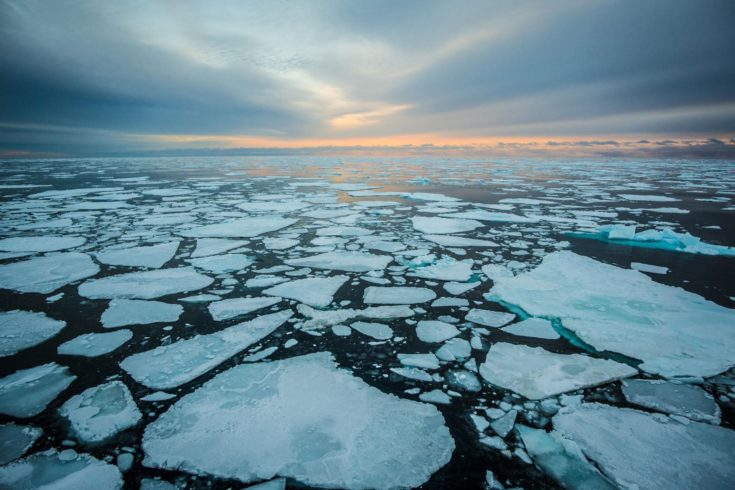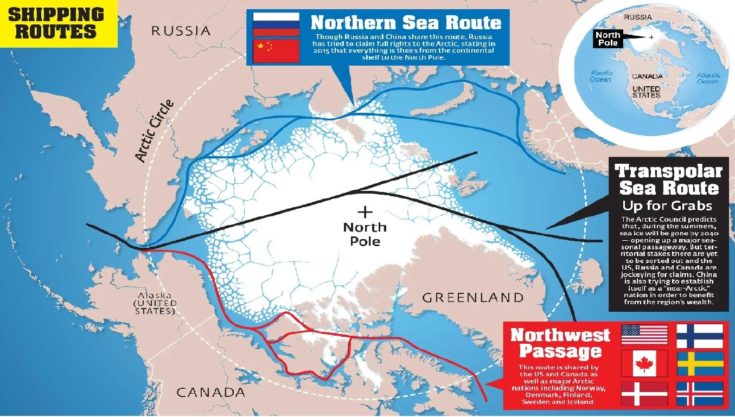
Fast-melting sea ice has opened a potential new Arctic shipping lane across the North Pole, which will give powerful nations easier access to the frozen zone’s vast riches — but has also sparked fears of war.
The Arctic Council predicts that, during the summers, sea ice will be gone by 2040 — allowing for a major new seasonal passageway. This Transpolar Sea Route (TSR) would be the fastest way to get around the region and could spur a spike in mining, drilling and trade over the next quarter-century.
Territorial stakes are yet to be sorted out. The US, Russia and six other countries — Canada, Denmark, Finland, Sweden, Iceland and Norway — are jockeying for claims to the surrounding area’s oil, gas and rare-earth minerals and metals: precious resources needed to power computers, phones, electric cars and satellites. China, meanwhile, is claiming “near Arctic” status so it, too, can benefit from the wealth of the region.
Today is a pivotal moment that is going to reshape the energy market and the supply chain,” said Rebekah Koffler, an intelligence analyst and author of “Putin’s Playbook: Russia’s Secret Plan to Defeat America.”
“The Arctic is going to be the future battlefield for economic dominance and possession of natural resources.”
The new passage, which runs about 2,000 nautical miles and was first crossed in 2012, currently is navigable only with high-level icebreaker ships.
But should melting ice make it more easily crossable, the TSR would offer lower costs and delivery times, particularly to Europe and Asia. It is hoped that tankers and cargo carriers will be able to sail over the top of the earth using the TSR in summer, saving more travel time than the two main coastline-hugging waterways that currently link the Arctic to southern ports.
“You could see a ship being sent right over the North Pole as early as 2035,” said Marc Lanteigne, an Arctic researcher in Norway. “Floating sea ice is still a hazard, but the degree of danger gets lower and lower each year.”
Vladimir Putin’s Russia and the United States under President Biden are among nine nations squaring off for control of the Arctic, where fast-rising temperatures could make the now-ice-covered region ship-navigable each summer as soon as 2040.
But the new passage could also escalate tensions between nations.
Last month, Russian President Vladimir Putin said his country will “knock out the teeth” of any foreign adversary that challenges its sovereignty over any territory it claims. While he didn’t specifically name the Arctic, Russia is currently massing a formidable array of military weapons in the region — including the Poseidon 2M39, a stealth nuclear-powered torpedo dubbed the “super-weapon.”

Days after Putin’s comments, President Biden warned that the climate change could “generate potential conflict in terms of dominating the Arctic.”
“The distance between Russia and NATO countries in the Arctic has been reduced to about 100 miles,” added Koffler. “And everyone is posturing for dominance. The US Army says we’re going to dominate the region, but the Russians have their own strategy. They’re screaming that they’re going to be the only non-NATO country in the Arctic Group. And China has joined the fight. They’re trying to tap into the Arctic as a major shipping route.”
For now, crossing the Arctic still requires an icebreaker like this Russian behemoth, the first to ferry natural gas across in 2018.
Until now, commercial shippers from the US, Canada and western Europe have relied on the Northwest Passage (NWP), which was opened widely in 2007. The Northern Sea Route (NSR), which started in 2017, is dominated by Russia.
Up for grabs is greater access to a region that holds 13% of the world’s untapped oil and 30% of its drillable natural gas, according to the US Geological Survey.
There’s also an estimated $1 trillion in metals and minerals, ranging from gold and silver to beryllium, cadmium and lithium — all in great demand due to the explosive growth of personal electronics and electric-battery cars.
While shipping, mining, drilling and fishing rights have been established along the Arctic coastal waterways for each country, none have been set for the wider Arctic. And it’s led to bitter disputes.
Source: NY Post

